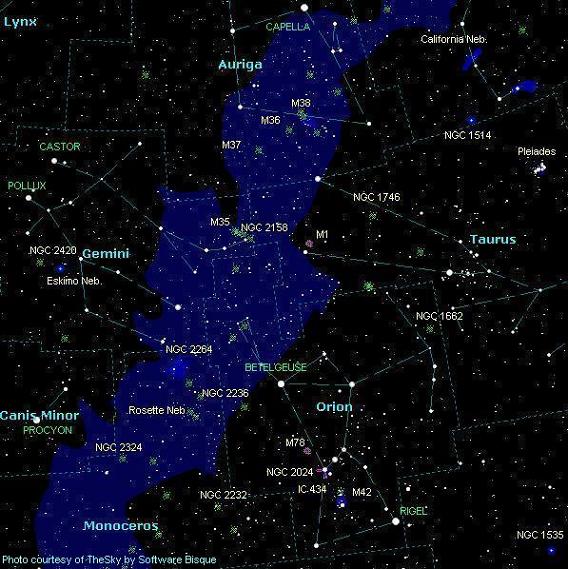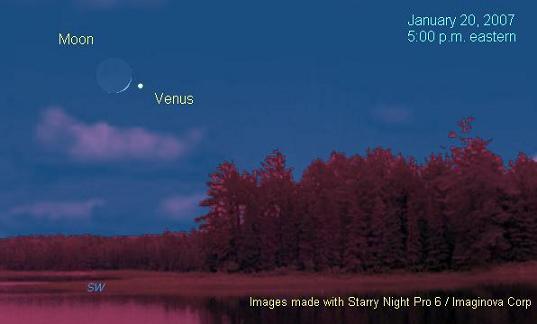A Winter Wonderland
Happy New Year everyone. I hope there were Astro presents under the Christmas tree with your name on them. If so and for those of you that already have a telescope or even binoculars, January night skies await. Stepping outdoors on the next clear moonless night, your eyes immediately pick up the brilliant suns of Auriga, Gemini, Orion, and Taurus. Eighteen of the brightest stars occupy these constellations and give the wintry sky a magical appearance.
What observing session does not include a stop to marvel the layout of the entire constellation of Orion, as our Hunter (as mythology states) battles Taurus the Bull. Moving down the sword from his belt is the most beautiful object in the night sky at this time of year, the Orion Nebula (M42). This stellar nursery can even be seen indoors with the lights dimmed. At a mere 1,500 light-years and some 42 light-years across, any instrument will award you a memorable soothing image of distant interstellar gas and dust as it slowly creates new stars. Large aperture telescopes will reveal fainter outer regions of the nebula dubbed, the “bat’s wings”.

The left-most star of Orion’s belt called Alnitak is 800 light-years from us and is a marker to a couple of challenging gaseous anomalies. From the gigantic dust clouds associated with the Orion complex, we can find the Flame Nebula just to the upper left of this 31,000° Kelvin supergiant star. Because it is placed so close to Alnitak, the star’s overpowering brightness masks the Flame’s appearance. Adjust the telescope position to simply move the star out of the field of view and the nebula will faintly come into view. What gives the flame’s appearance is the obscuring dust placed in front of the reflection nebula, blocking the backlight.
One of the most difficult objects to spot visually is the Horsehead Nebula (IC 434). Although photography portrays it as an observable object, only the combination of a large telescope and dark skies will catch these photons in the eyepiece. The silhouette of the Horse is simply a thick region of obscuring dust compared to the lower thinner patch of dust of which only the brightest stars protrudes through. Visually, it is like looking at dark grey in front of lighter grey. I have only seen it one in a 25-inch dobsonian.

Moving up a quarter the way from Alnitak to Betelgeuse, you will unveil a couple of items, the larger M78 and smaller NGC 2071. M78 is a reflection nebula that is also associated with the Orion complex is being lit by two B type stars deep inside the cloud. It is an estimated 1,600 ly from us and at magnitude 8.3, M78 should not be too hard to pick up.
Scooting on over to Monoceros, we have a nice, somewhat rich open cluster named NGC 2324. And let’s not forget the Rosette Nebula catalogued as NGC 2244. This large emission nebula takes up the area of 5 full moons and is still in the process of star formation. Depending on your telescope’s focal length along with the Rosette’s enormous size you will have a difficult time trying to keep the entire object in the field of view. It is some 5,500 light-years from us. The real giveaway to locating the Rosette is the group of three double stars.
Before you leave Gemini, do drop by a true winter object – the Eskimo Nebula, NGC 2392. You will detect a colour change in this planetary nebula as well as seeing the central star. A professional photo like the Hubble Space Telescope shows unusual one light-year long filaments forming the Eskimo’s parka along with the inner structure of solar winds sculpting the facial structure.
Marching on over to Taurus, look for the remains of a star that exploded on July 4, 1054 AD. Numero uno on the Messier list, M1 (aka the Crab Nebula), shows as a ghostly patch of grey barely glowing at magnitude 8.4 but does sport a bit of structure. When this supernova went off, it easily outshone the full moon for 23 nights. That must have been a sight to see. The particles are still racing away from the point of impact at about 1,300 km per second. The energy released during the explosion equalled about 400,000,000 Suns worth. Our last stop is the constellation Auriga as it sports three open cluster Messiers named M36, M37 and M38 with magnitudes of 6.0, 5.6 and 6.4 respectively. Of the three, M37 stands out as the brightest and prettiest with an even papering of distant suns.
The ringed marvel Saturn is a definite show stopper. The rings are an inspiring sight in any scope especially with Cassini’s 4,300 km. division. It amazing that at the immense distance between our worlds of 1.3 billion kilometres, this division stands out and is about one-third Earth’s diameter. A larger telescope can catch up to five Saturnian moons as they dance around the gas giant.
Venus is slowing marching up the WSW skies and stays low as she pulls away from the Sun’s glare. Jupiter, on the other hand, is beginning to dominate the eastern skies, rising an hour before twilight begins and will rise a full three hours by month’s end.
Full Moon for January – the Wolf Moon occurs on January 3rd and is also the night of the Quadrantid meteor shower. This shower can produce up to about 40 meteors per hour as seen by a single observer. Some of these can stretch across the entire sky while moving about 42 km per second. The new moon is slated for January 18th.
Until next month, clear skies everyone.
Gary Boyle

| Object | Type | Magnitude | RA | DEC |
|---|---|---|---|---|
| IC 434 | Diffuse Neb. | Faint | 05h 41m | -02° 23' |
| M 35 | Open Cluster | 5.1 | 06h 09m | +24° 20' |
| M 36 | Open Cluster | 6.0 | 05h 36m | +34° 08' |
| M 37 | Open Cluster | 5.6 | 05h 52m | +32° 33' |
| M 38 | Open Cluster | 6.4 | 05h 29m | +35° 51' |
| M 42 | Emission Neb. | 4.0 | 05h 36m | -05° 26' |
| M 78 | Reflection Neb. | 8.0 | 05h 47m | +00° 03' |
| NGC 1514 | Open Cluster | 6.0 | 05h 04m | +23° 59' |
| NGC 1535 | Planetary Neb. | 10.0 | 04h 14m | -12° 42' |
| NGC 1662 | Open Cluster | 6.4 | 4h 49m | +10° 56' |
| NGC 1746 | Open Cluster | 6.0 | 05h 04m | +23° 50' |
| NGC 2042 | Reflection Neb. | 8.2 | 05h 41m | -01° 56' |
| NGC 2158 | Open Cluster | 8.6 | 06h 08m | +24° 06' |
| NGC 2232 | Open Cluster | 3.9 | 06h 27m | -04° 55' |
| NGC 2244 | Open Cl + Neb. | 4.8 | 06h 32m | +04° 52' |
| NGC 2264 | Open Cl + Neb. | 3.9 | 06h 42m | +09° 53' |
| NGC 2324 | Open Cluster | 8.4 | 07h 04m | +01° 03' |
| NGC 2392 | Planetary Neb. | 10.0 | 7h 30m | +20° 54' |
| NGC 2420 | Open Cluster | 8.3 | 07h 39m | +21° 33' |
